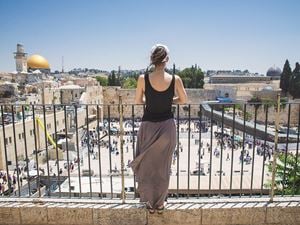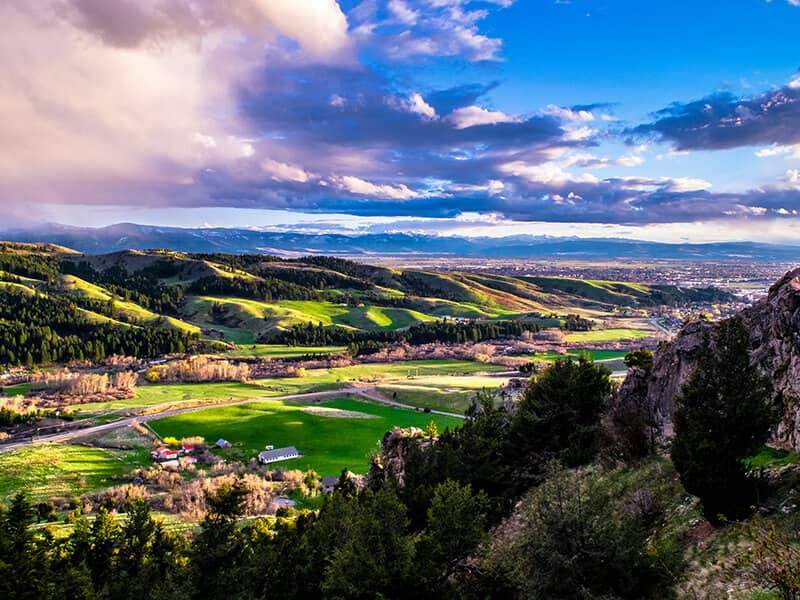
My broken camera became the catalyst to the practice of what I now call "travel presence." I will travel with a camera again, but I also intend to make this kind of presence my more reliable companion.
I was on this pilgrimage to be in the Holy Land. Too often, though, the typical activities of an organized tour, including all the stops for photo and shopping opportunities, take us out of the moment to the future--to the time when we are showing our pictures or looking at our souvenirs and gifts. What, then, did I learn about the practice of travel presence? The following tips are based on travel to the Holy Land, but they apply just as well to any guided tour.
Don't expect to be alone. Many people feel that they need to have some quiet time in a holy place for the experience to be meaningful. This is hard to do on a tour when you are allotted perhaps one-half hour at a site, and the guide talks through most of the visit. This background information is often very valuable, giving you a sense of the history and tradition associated with a place. So listen but also observe. The devotion of other pilgrims may touch you in surprising ways.
On my first visit to the Church of the Holy Sepulchre in Jerusalem, I found myself rather taken aback by all the lamps, icons, and other decorations so different from the plain decor of the churches of my Protestant upbringing. But then I noticed a young woman kneeling at the slab of rock where the anointing of Jesus' body after the crucifixion is remembered. She touched the stone with such tenderness, I was pulled right out of my denial and into the presence of my own compassion for Jesus and all the others who suffer today.
In such a place, other pilgrims add to the tapestry of your experience, even if their expressions of devotion are different from your own.
Of course, if you stay in the back of your group, you may have a few minutes of quiet while the others are taking pictures or browsing through the souvenir shop. If you have already read about the significance of a site, you can step out of the range of your guide's voice to be by yourself. Be sure to rendezvous with your group on schedule, however. Nothing spoils the glow of a private moment as quickly as the exasperated looks of others who have had to wait for you.
Make connections. In a city like Jerusalem, it's not difficult to think about the generations that have gone before you and those yet to come. The tour guide's talk is peppered with dates, descriptions of historical events, and explanations of the traditional significance of places you are visiting. Practice presence in each place by remembering the cloud of witnesses that have been there before you and also the silent witnesses that remain. Some of the olive trees in the Garden of Gethsemane have been carbon dated to the time of Jesus; they were witnesses to his agonized prayers. Put yourself in their place, hear with their ears. Where are the prayers of agony coming from today?
Jerusalem is a city of stone. Israel, in fact, is a stone lover's paradise. The pavement stones in the lower levels of the city have been dated by archaeologists to specific periods. The walls of the churches, mosques, and synagogues have seen parades of pilgrims and too many battles to be counted. As you walk on these ancient paths or touch these solid walls, ask yourself, "What would these particular stones tell me if they could speak?"
Be open to other religious traditions. I traveled to Israel to attend a conference sponsored by Shambhala Publications on spiritual practices in four traditions--Buddhism, Christianity, Islam, and Judaism. After a week at the Sea of Galilee, we drove up to Jerusalem. At Mount Scopus, we got off our buses and gathered to get our first view of the Old City. Two Jewish members of our group offered prayers in Hebrew. A Sufi sheik recited the Fatiha in English and Arabic. We sang responsively as a Catholic monk read Psalm 122, a prayer for the peace of Jerusalem. We greeted the Holy City in the languages and traditional practices of the three faiths that call Jerusalem home.
Throughout your pilgrimage, you can practice presence by noticing both the diversity and the unity of spiritual practices. Hearing the call to prayer from a mosque, I found myself recalling how many traditions call out specific times for prayer through chimes, bells, or voices broadcast from a minaret. What cues to prayer, I wondered, can I incorporate into my daily life when I get home? Noticing how the whole atmosphere of Jerusalem changed on the Jewish Sabbath, I renewed my commitment to observe a day of rest.
Write notes and keep a journal. I was writing in my journal one day when another tour group passed by. A woman exclaimed, "I want to keep a journal too, but I never have time. To write I'd have to miss something." I know the feeling. Most tours are really packed with activities. One tip to all would-be journal writers: Give up the idea of keeping your trip diary chronological. If you try to keep it orderly, you'll soon fall behind and end up with a few days recorded in detail and the rest lost in frustration. Practice travel presence by letting your journal just happen.
My Israel journal is in two 5" x 7" notebooks, one of which I always carried in the back pocket of my purse. It has my notes from the lectures at the conference I was attending, the times for breakfast, when the bus would leave, addresses of people I met, and notes taken during the guide's talks. In the back I kept a running list of impressions I wanted to write about when I had more time. Some of those entries I did while sitting in the bus and even while waiting in the bathroom line. Others I wrote back in the hotel. I also bought postcards in the hotel of places I knew were on the agenda, then jotted notes to myself on the back of them. (And yes, I did take one day off from touring, missing something but doing the reflecting that was important to me.)
I discovered making brief notes as I went along helped keep me in the moment. This practice periodically cleared my mind of things I was struggling not to forget. That way I could be more open to new experiences.
Participate in present-day life. When you are traveling to a place with a rich past, sometimes that is all you focus on. But presence means being here now. Once in New York City where I live, I was surprised to find one of my favorite grocery stores filled with tourists from a large bus parked outside. "How silly," I thought to myself. "They are seeing a market on their tour." But then I realized that one of my favorite things to do in a foreign country is to visit a market. My senses come alive as I see the stalls of sweets, touch the unusual fruits and vegetables, smell the bins of spices. So on your next tour, try local foods. Put the strange green spice on the sesame seed bread bought from a cart in the Old City. Try eating olives and herring and eggplant jam for breakfast. All this is the spiritual practice of wonder, and if travel is anything, it is wonder-full.

